Premier League
Champions League final: 4 key questions, prediction for Man City vs. Inter

The blue halves of Manchester and Milan are converging on the biggest stage in club football.
Manchester City and Inter Milan saved their first-ever competitive meeting for Saturday’s Champions League final in Istanbul. Beaten 2021 finalists City are still trying to crown Pep Guardiola’s glittering era with their inaugural triumph in European football’s top competition, while Inter are attempting to hoist the trophy for the fourth time after overcoming a 13-year run of failing to advance beyond the quarterfinals.
Here are the key questions and a prediction for the much-anticipated clash in Turkey:
Will Guardiola tweak his system?
The fundamentals of Manchester City’s approach haven’t changed. This season, they still led the Premier League in the usual metrics – such as possession and time in the opponents’ half – and remained bottom in statistics such as frequency of long passes and speed of attacks.
Continuity is what makes this version of City most different from others during the Guardiola era. There are fewer question marks about what the Spaniard will do for the big matches: Overthinking – a lazy media critique that leaned on the few instances a novel approach went wrong and disregarded the many times a Guardiola tweak paid off – has been increasingly unlikely as the season progressed.
Obviously, last summer’s addition of Erling Haaland ended Guardiola’s use of a false nine – and it required various experiments before an effective scheme was devised. To oblige an out-and-out striker who maintains a narrow position and has few touches of the ball, Bernardo Silva and Jack Grealish have become the go-to wingers who can track back to cover defensive lapses. Traditional or inverted full-backs are discarded, with four center-backs (including John Stones, whose importance to the team has catapulted since he adopted a hybrid defender-midfielder role) forming a barrier against counter-attacks with defensive midfielder Rodri.
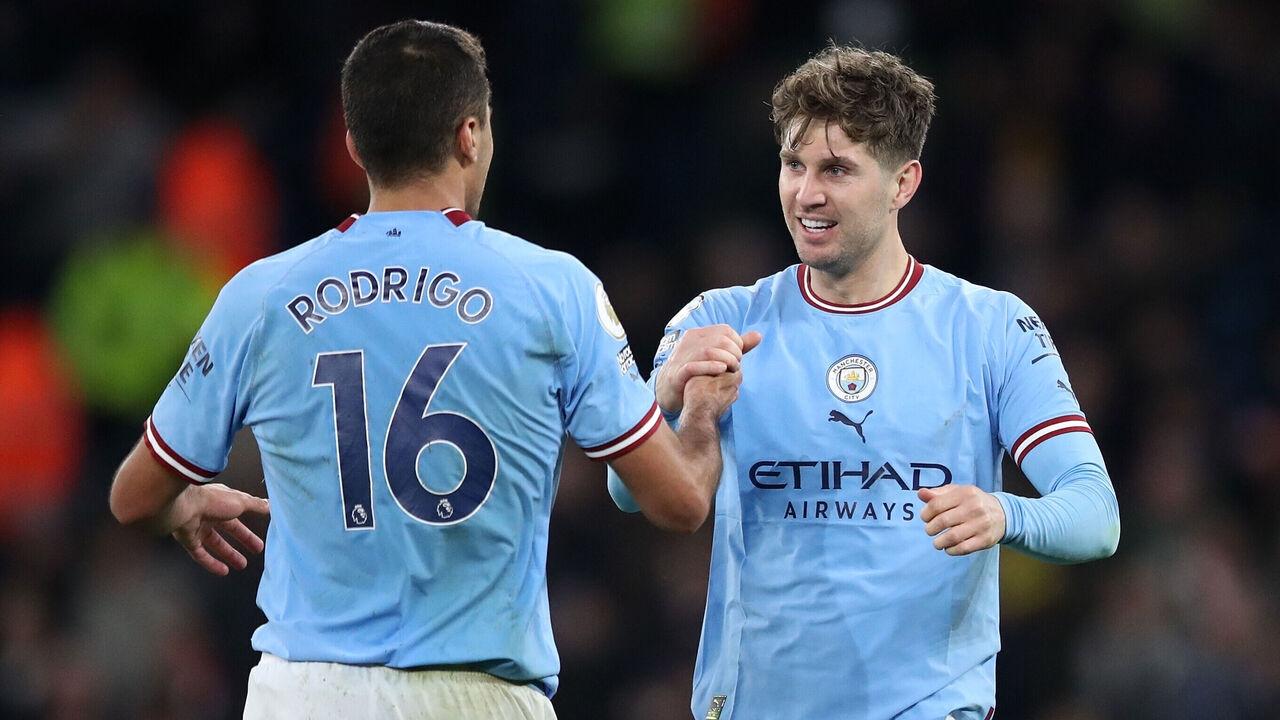
The general formation is a 3-2-4-1, with Stones and Rodri often at the bottom corners of a midfield square with Ilkay Gundogan and Kevin De Bruyne ahead of them. The shape is fluid – this is a Guardiola team, after all – but, in the most basic terms, City have a setup of five defense-minded players behind a fearsome attacking quintet. This is the most defensive organization Guardiola has had at City – but that hasn’t diluted the upfield threat.
Guardiola famously – or infamously – mirrored Lyon’s back-three when City were eliminated in the 2019-20 Champions League quarterfinals, but don’t expect him to make the same mistake against Inter Milan’s 3-5-2 formation. Back then, he switched his defense throughout the season while he dealt with Nicolas Otamendi’s impulsiveness and Aymeric Laporte’s injury problems. Now, he has more trust in his defense than he’s had throughout his City tenure. His recent success with the revised foundation of four center-backs speaks for itself.
Don’t expect a Pep curveball this time around.
Lukaku or Dzeko?
Inter’s biggest selection conundrum is who partners with Lautaro Martinez in attack.
Former Manchester City striker Edin Dzeko didn’t get a goal between mid-January and the start of May. However, he started each of Inter’s six Champions League knockout matches and the final two rounds of the Coppa Italia. He’s further enhanced his reputation as a big-game player courtesy of his first-leg volley against AC Milan in the Champions League semifinals and his continued selfless yet eye-catching graft up front.
It’s natural to lean on Dzeko’s aerial attributes given his size, but his passing over medium and long ranges is more accurate than his forward rival Romelu Lukaku. Martinez and the Inter midfielders joining attacks undoubtedly appreciate that distribution.
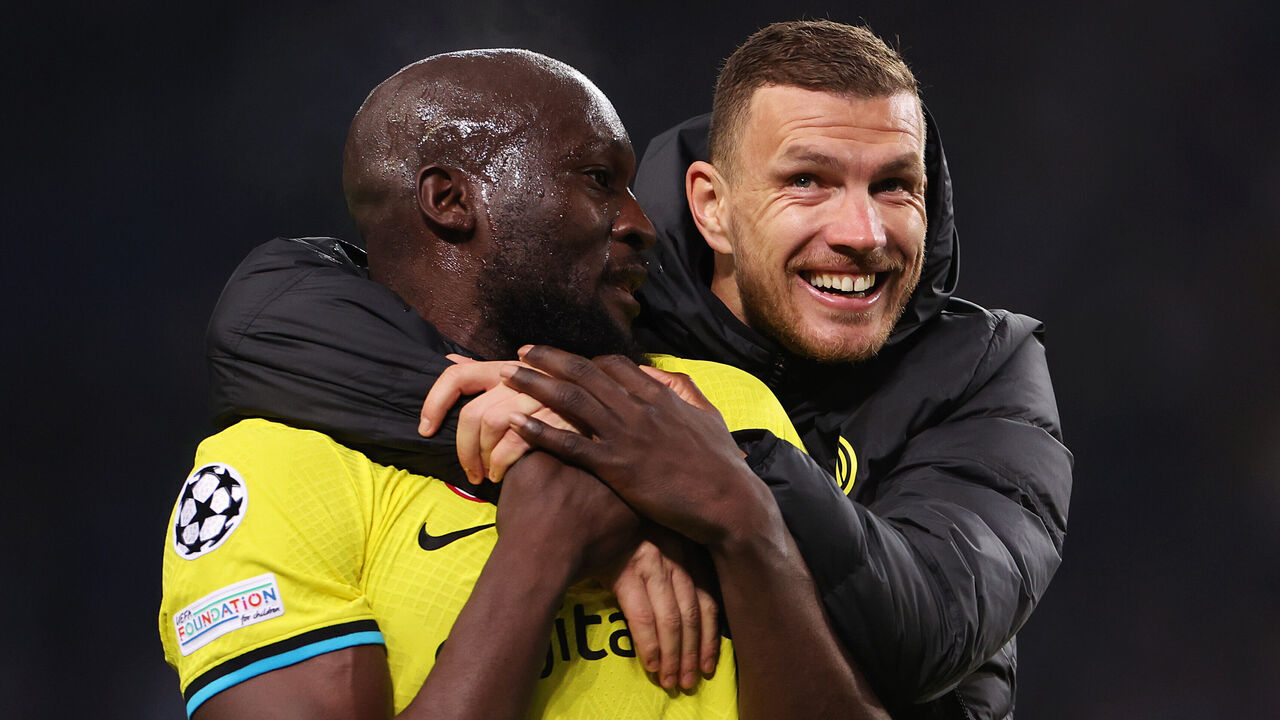
Lukaku had to wait until Feb. 18 to get his second Serie A goal of the campaign, but his performances since the March international break could force him into the Champions League final lineup ahead of Dzeko. His nine goals and six assists helped Inter finish third in Serie A and automatically qualify for next season’s Champions League group stage.
And before Lukaku went back to Chelsea in 2021, the Belgian and Martinez arguably formed the best striking duo in Europe. They combined for 41 Serie A goals during Inter’s 2020-21 title-winning campaign.
2022-23 statistics per 90 minutes (all competitions):
| Stat | Dzeko | Lukaku |
|---|---|---|
| Goals | 0.44 | 0.64 |
| Shots | 3.30 | 2.89 |
| Assists | 0.32 | 0.13 |
| Inter goals minus opposition goals | +1.24 | +0.64 |
“They are two different players,” Martinez said of the strikers who share minutes beside him. “Edin likes to have the ball; he comes to meet and connect play with his teammates, while Romelu prefers to attack spaces and gets behind defenders so he can create space for the other striker. I get along with them very well.”
Dzeko is a better team player, and Lukaku is a more reliable finisher. Simone Inzaghi needs to choose which of these talents is most valuable to have from the start of Saturday’s final.
Is Haaland actually in a goal drought?
Haaland has scored once in his last seven appearances. Over the same span, Julian Alvarez has notched two goals in around 150 fewer minutes.
A similar dry spell earlier in the season would’ve caused legitimate concern. It took just one game – Haaland’s underwhelming debut in City’s Community Shield defeat to Liverpool – for many to predict the Norwegian marksman would have a tough acclimation to English football.
But Haaland has gone on to score 52 times across all competitions, and City are on the verge of a historic treble, so his current drop in productivity isn’t a huge talking point.

And Inter know there’s a lot more to worry about than just Haaland.
“It’s not Haaland versus Inter; it’s Manchester City versus Inter,” Inter defender Alessandro Bastoni said.
Other players have stepped up while Haaland’s scoring output dipped. Silva dizzied Real Madrid with two goals during the second leg of their Champions League semifinal scuffle. Gundogan – who tends to flourish in spring – notched braces in Premier League matches against Leeds United and Everton and in last Saturday’s FA Cup final scuffle with Manchester United, practically securing two-thirds of City’s potential trophy haul in the 2022-23 season.
Haaland has been far from a bystander during the business end of the season, though. When a teammate scores a goal, he’s often sandwiched between two defenders or has been involved in the buildup. His improved link-up play and willingness to attract opponents, giving his colleagues more room, have been key developments late in the season.
The 22-year-old’s drought might drag on in the Champions League final, but it doesn’t matter so much when he’s already improved exponentially in other areas of his game.
Can Darmian and Dumfries silence Grealish?
One side of the pitch could cancel itself out. Federico Dimarco is an important part of Inter’s weaponry when he pours forward, but he doesn’t often face a defender like Kyle Walker. Neymar has previously identified the Englishman as the toughest opponent he’s faced, and Vinicius Junior was regularly outpaced and outmuscled by Walker in the semifinals. The indefatigable Silva, who plays ahead of Walker, boosts City’s sturdiness on this side.
The most intriguing matchup could instead be where City focus most of their attacks: Grealish’s left flank.

Matteo Darmian established himself on the right of Inter’s defensive trio while Milan Skriniar dealt with back issues, and the ex-Manchester United full-back has proven a more proactive tackler than his fellow center-backs. At right wing-back, Denzel Dumfries enthusiastically runs into enemy territory, but his excellent defensive performance over two legs against Milan’s Theo Hernandez was pivotal to Inter’s relatively comfortable progression from the semifinal stage.
Nevertheless, it must be noted that Darmian and Dumfries were spared from facing the true Rafael Leao. The rapid Portuguese wideman was injured for the opening game and then clearly below match fitness for the return leg, significantly lessening the Inter duo’s workload at the back. They didn’t face Milan at their best.
So, Darmian and Dumfries may have never doubled up against a winger of Grealish’s ilk. The floppy-haired playmaker is perhaps most dangerous when natural left-footer Nathan Ake is behind him, overlapping to stretch the defense and pry open holes for Grealish to dribble inside. There, Grealish can slide a ball through to a teammate, shoot with his stronger right foot, or win a foul. The spaces aren’t quite the same for Grealish when the right-footed Manuel Akanji is behind him.
How it could play out
Manchester City are better than Inter Milan. Few would disagree with that.
However, over 90 minutes – or 120 minutes, or 120 minutes plus penalties – anything can happen. Real Madrid were second-best during most of their fortuitous run to last season’s Champions League final, but they still collected their record-extending 14th European crown.
The finalists’ road to Istanbul (with aggregate scorelines):
| Stage | Man City | Inter |
|---|---|---|
| Round of 16 | 8-1 vs. RB Leipzig | 1-0 vs. FC Porto |
| Quarterfinals | 4-1 vs. Bayern Munich | 5-3 vs. Benfica |
| Semifinals | 5-1 vs. Real Madrid | 3-0 vs. AC Milan |
The job that Inzaghi has done at Inter is underappreciated. He took over a team reeling from the club’s financial issues and dealing with the usual rubble and refuge that Antonio Conte tends to leave behind after his tumultuous reigns. Achraf Hakimi and Lukaku were transferred out the same summer as Inzaghi’s arrival, and Christian Eriksen had to leave because the defibrillator that was fitted after his cardiac arrest made him ineligible to play in Italy. Ivan Perisic left before this campaign.
Despite all of this, Inzaghi has developed a reputation as a cup specialist. He’s won the Coppa Italia and Supercoppa twice each with Inter, adding to his achievements during his previous job at Lazio (one Coppa Italia and two Super Cups). He’s now presiding over Inter’s first Champions League final since 2010.
But this is Manchester City – and arguably the most balanced and mature side Guardiola has managed over his seven years with the club. The strength of this team has given the Catalonian the confidence to defend one-goal leads; rather than relying on keeping the ball away from opponents late in matches, he introduces more defenders to tackle and block at one end of the pitch while Haaland wins time-draining corner-kicks at the other end. His game management is much better.
City currently appear to be the complete package. They should have too much for Inter.
Prediction: 2-0 to Manchester City after 90 minutes
Copyright © 2023 Score Media Ventures Inc. All rights reserved. Certain content reproduced under license.
You may like
Premier League
Breaking down thrilling EPL title race with 10 games left

Find the biggest stories from across the soccer world by visiting our Top Soccer News section and subscribing to push notifications.
One of the most intoxicating title races in Premier League history is, mercifully, ready to resume.
The quirks of the calendar – an FA Cup weekend succeeded by an agonizing international window – means the titanic tussle between Arsenal, Liverpool, and Manchester City will have been on hiatus for a full three weeks before it gets back underway on Sunday.
But there are no more impending interruptions. With 10 matches remaining for each title contender, we’re barreling toward a resolution to the type of three-way battle that’s exceedingly rare in England’s top flight. There’s never been a season in the Premier League era where three teams went into the final day with a chance to hoist the trophy. This could be it. The last time it happened was the 1971-72 campaign, when Derby County won an incredible four-team fight, narrowly beating Leeds United and, ominously, Liverpool and Man City to the crown. We’re overdue for that kind of drama.
That three sides have converged this way at all is, frankly, remarkable.
These are the three best teams in the country by an enormous margin. They’re the only ones with an expected goal difference per game of plus-1.0 or greater this season. The next best mark, surprisingly, belongs to Mauricio Pochettino’s erratic Chelsea team at plus-0.36. So, yeah, it’s not close.
The three of them are also on a tear and show no signs of slowing down. Arsenal have won all eight of their league games in 2024, scoring 33 goals in the process; Liverpool have collected 22 of a possible 27 points in that time; reigning champions Manchester City have racked up 23 of 27 points. They’ve combined for just one loss since the calendar flipped – Liverpool’s 3-1 defeat against Arsenal in early February.
The only sides that look capable of halting their progress are each other, which makes this weekend’s clash between Manchester City and Arsenal at the Etihad all the more significant.
Each contender has a compelling reason for believing it’s “their” year.
Arsenal
Mikel Arteta’s men look far more assured and mature than last season when they set the pace for nearly the entire campaign, only to crumble down the stretch and relinquish their once sizeable advantage to Manchester City. Do-it-all superstar Declan Rice has been a transformative figure in midfield, while Kai Havertz, after an inauspicious start, is becoming an increasingly vital and consistent scoring threat. At least from the outside, there appears to be more self-belief within the Arsenal camp. Having learned from their experience in 2022-23, Arsenal won’t cede top spot so easily this time. It’ll need to be ripped from them.
Some may be inclined to dismiss their recent run because of their opponents. Yes, the Gunners have played some weak teams – Sheffield United! Burnley! Nottingham Forest! – but, for the most part, they aren’t just beating them; they’re blowing them away with a ruthlessness usually associated with title winners. For those still unconvinced, Sunday’s visit to the Etihad, where they were tossed aside like a rag doll in last season’s 4-1 loss, will be the ultimate litmus test to see if this team is ready to end the club’s 20-year title drought.
Liverpool
Jurgen Klopp’s persistent squad, already with the League Cup in tow, aims to send off their departing bench boss in style. Liverpool have been the most entertaining team of the trio this season. They create more chances than Arsenal and City and concede more opportunities. Darwin Nunez, the ultimate agent of chaos on a football pitch, is the perfect fit for a team with a habit of scoring late goals and delivering dramatic moments. Their title charge is built on more than just vibes, though.
Liverpool overwhelmed none other than City in their last league game before the international break but came away from the pulsating affair at Anfield with a 1-1 draw. City, usually self-confident and domineering in possession, simply held on against what Pep Guardiola dubbed a “tsunami” of pressure. There was obviously some added incentive at play, but Liverpool are built to go full speed regardless of the opposition. It’s in their nature under Klopp.
Manchester City
Despite not being at its vintage best this term, Guardiola’s accomplished crew remains the favorite in the eyes of many who, for good reason, simply refuse to pick against them. We’ve been conditioned to feel like City will inevitably be the last team standing because, well, they usually are. Five titles in the previous six seasons will have that effect on the collective psyche. However, Erling Haaland isn’t replicating his ferocious scoring pace from last season, and Kevin De Bruyne has been limited to six league starts. Also, outside of some electrifying Jeremy Doku performances, the summer signings haven’t exactly set the world alight. And yet, here they are, just one point off the top, showing the quiet confidence and tranquility that can only be obtained through winning experiences.
With Phil Foden leading the way and authoring arguably the best season of anyone in the league, City could become the first team in English history to win four consecutive top-flight titles.
Strength of schedule
On paper, Arsenal have the most difficult fixture list.
Their remaining opponents average 41.8 points this season, roughly corresponding to ninth place in the table. Put another way, it would be the equivalent of playing Wolves (41 points) or Brighton (42) each week. It doesn’t help that many of Arsenal’s toughest matches are away from home. Coincidentally, they have upcoming trips to Brighton and Wolves, along with north London rivals Tottenham and Manchester United, following this weekend’s potentially decisive tilt at the Etihad. It’s tough.
Manchester City’s task is slightly more forgiving, as their remaining opponents average 40.7 points or 10th place.
Liverpool appear to have the most favorable schedule of the trophy chasers, with their opponents averaging 38.4 points, a tally representing the haul of a team in the bottom half of the table. While that’s better than the alternative, it’s not quite so simple for the Reds. On the back of a potentially draining Europa League quarterfinal second leg against Atalanta in mid-April – more on that soon – Klopp’s men have three away games in seven days against Fulham, Everton, and West Ham. In addition to battling their local nemesis, who could still be scrapping for survival at that point, Liverpool will also face a rambunctious Goodison crowd that would love nothing more than to play a critical role in stopping their hated rivals from winning another league crown.
Aston Villa and Spurs, meanwhile, stand out as common foes for all three title hopefuls. Sitting fourth and fifth, respectively, and engaged in their own fight to secure a Champions League place, they could play the role of kingmakers this spring.
European commitments

Balancing the mental and physical demands of domestic play with continental competition is a huge piece of this puzzle for all three teams. Midweek success can further galvanize a group, but taxing failures can cripple a team’s momentum at home.
Much like the domestic schedule, Liverpool seem to have an edge here. Arsenal and Manchester City will face European behemoths Bayern Munich and Real Madrid in a pair of mouthwatering Champions League quarterfinal ties beginning next month. However, Liverpool have a comparatively charitable Europa League encounter with Atalanta.
If they both advance, Arsenal and City will meet in the Champions League semifinals, an outcome that will surely be celebrated wildly on Merseyside.
How those games intermingle with the league schedule also matters. Liverpool play Crystal Palace and Fulham following their two matchups with the Italian outfit. After locking horns with Bayern, Arsenal have to contend with Aston Villa and Wolves. Manchester City, still active on three fronts as they seek a second consecutive treble, host lowly Luton after the first leg of their Real Madrid rematch and take on Chelsea in the FA Cup semifinals following the second leg.
Injury concerns
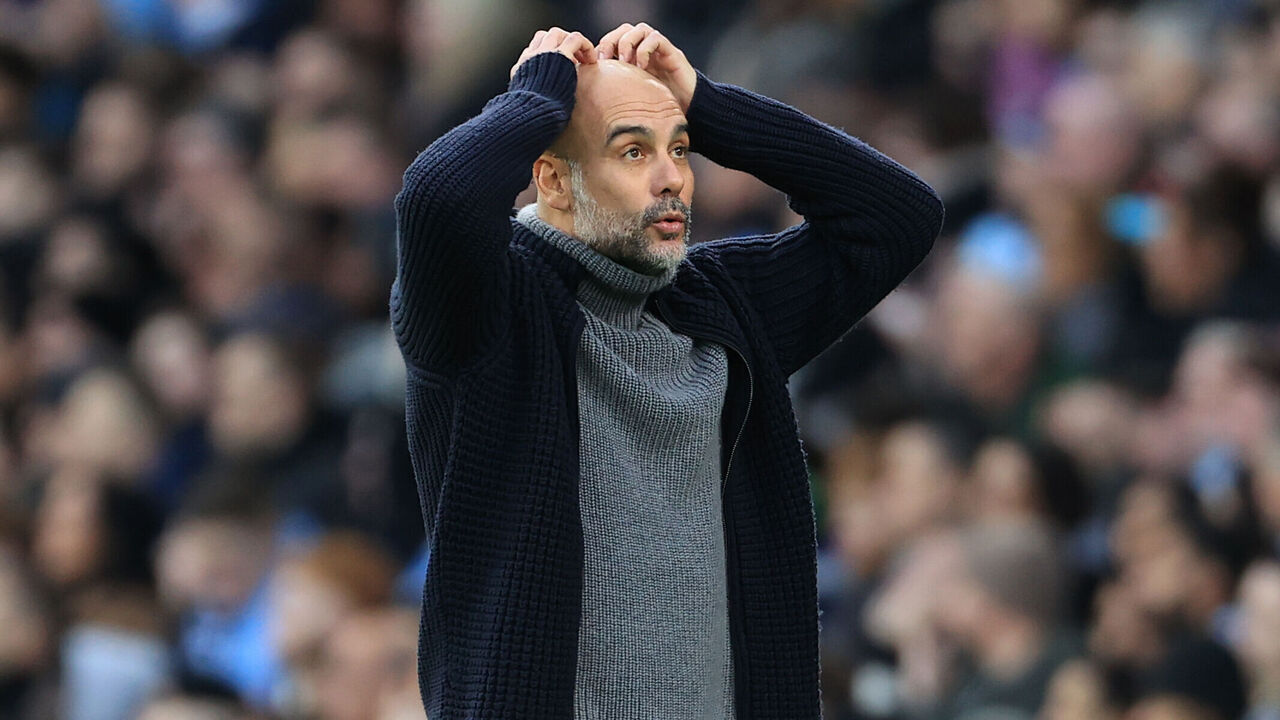
Liverpool have been plagued by injuries all season. Mohamed Salah, Trent Alexander-Arnold, Darwin Nunez, Diogo Jota, and Andy Robertson, among others, have missed varying amounts of time, though the bulk of that group is getting back to full fitness. Alisson Becker remains sidelined and might not return until mid-April. Defensive stalwart Virgil van Dijk is the only Liverpool player to garner over 2,000 league minutes this season, indicating how disruptive injuries have been for Klopp’s team. And yet, they persevere.
Five Manchester City players have cleared the 2,000-minute mark thus far, and a couple more are on the cusp. But the club was without De Bruyne for the entire first half of the season, while trips to the treatment room ravaged Jack Grealish’s year. City also got hit the hardest by the recent international break, with John Stones and Kyle Walker hurt on England duty and racing against time to recover for Sunday’s match versus Arsenal. Swiss defender Manuel Akanji is in the same boat, and Ederson’s return date from a thigh injury remains uncertain. Never shy about tweaking his lineup, Guardiola could be forced to tinker yet again.
Arsenal have been largely unscathed, with six players eclipsing 2,000 league minutes. William Saliba, whose absence last season played an outsize role in Arsenal’s capitulation, has been on the pitch for every second of league play in 2023-24. Gabriel Jesus has battled ailments all year, and Jurrien Timber suffered an ACL injury just 49 minutes into his Premier League debut in the season opener. But the Gunners will be hoping their relative good fortune on the injury front extends right through May, especially as it relates to Bukayo Saka, who pulled out of the England squad to nurse a minor muscular issue.
Prediction
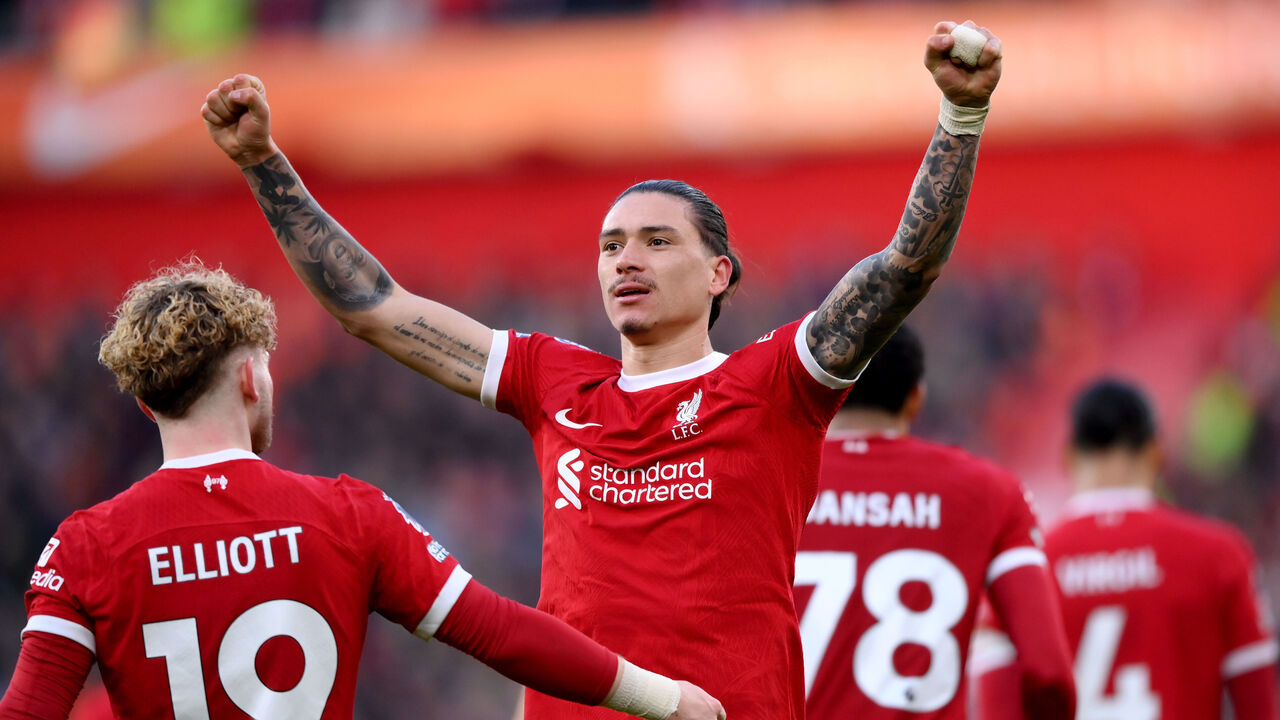
First, a disclaimer: Luck will play a pivotal role in determining which team is crowned on May 19. Injuries will continue to be a factor. There will almost certainly be contentious refereeing and VAR decisions that favor and oppose the title challengers. There will also be finishing variance, with players missing seemingly easy chances and converting more difficult opportunities.
Impossible to predict? No matter. We’re not going to let that stop us.
Considering their advantageous schedule, at home and in Europe, along with their improving squad health at just the right time and the inescapable feeling that this is a team of destiny determined to send their beloved manager out on a high, we’re going with Liverpool, who’ll collect 88 points to pip their rivals and again interrupt Manchester City’s run of domestic dominance.
Copyright © 2024 Score Media Ventures Inc. All rights reserved. Certain content reproduced under license.
Premier League
Euro 2024 playoffs: Miraculous Ukraine comeback, big result for Wales

Find the biggest stories from across the soccer world by visiting our Top Soccer News section and subscribing to push notifications.
Wales, Greece, and Poland registered statement wins Thursday, joining three other teams in next Tuesday’s playoff finals for the three remaining places at Euro 2024.
Ukraine staged an incredible late comeback against Bosnia and Herzegovina in its semifinal to keep its Euro dream alive.
The highest-placed team in FIFA’s rankings that’s no longer in contention to reach the tournament in Germany is 60th-placed Finland.
Here’s how the playoff semifinals across Path A, B, and C played out.
Path A

Poland 5-1 Estonia
Estonia barely stood a chance. Down to 10 men as early as the 27th minute, the northern Europeans could only muster a consolation goal in a 5-1 loss to Poland. The Polish achieved the rout without Robert Lewandowski getting on the scoresheet and remain unbeaten in 21 Euro qualifiers at home, a magnificent run dating back to September 2006. Poland is trying to make up for a poor qualifying campaign in which it finished third in Group E, four points behind the Czech Republic and Albania. The country hasn’t missed the Euros since 2004.
Wales 4-1 Finland
The Red Wall might descend on Germany this summer. Wales’ raucous supporters have legitimate hopes of traveling to another major tournament after the Dragons scorched Finland without the retired Gareth Bale and with Aaron Ramsey, 33, on the bench after more injury problems. Teemu Pukki gave the visiting team some hope just before halftime following well-taken finishes from David Brooks and Neco Williams. But Wales needed just 73 seconds of the second period to restore its two-goal cushion via Brennan Johnson’s tap-in. Daniel James took advantage of a defensive error before rounding the goalkeeper in the 86th minute to give the host a resounding victory.
Playoff final: Wales vs. Poland, Tuesday 3:45 p.m. ET
Path B
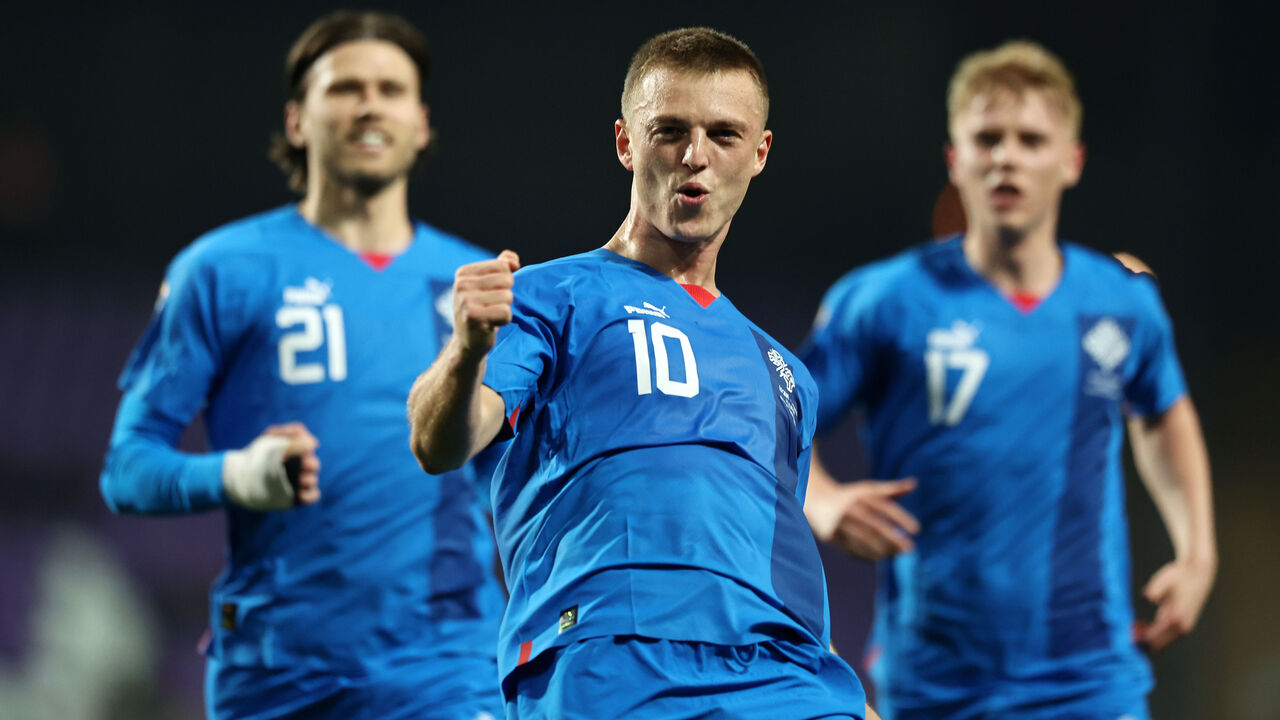
Israel 1-4 Iceland
Iceland’s Albert Gudmundsson stole the show with an emphatic hat-trick against Israel on Thursday. His stunning free-kick into the top right corner canceled out Eran Zahavi’s opening goal for Israel, and he created a nice cushion for his country with a pair of markers in the final 10 minutes. Just before that, Zahavi blew an incredible opportunity to equalize the match at 2-2, missing a penalty awarded for handball against Iceland’s Gudmundur Thorarinsson. A red card to Israel’s Haim Revivo didn’t help the trailing side. Iceland is now a game away from making only its second-ever appearance at the Euros following its quarterfinal run in 2016.
Bosnia and Herzegovina 1-2 Ukraine
Ukraine scored twice with just minutes remaining in regulation to snatch what seemed to be a sure victory from Bosnia and Herzegovina on Thursday. Bosnia controlled play for most of the match and took the lead in the 56th minute when Mykola Matviyenko turned in Amar Dedic’s shot into his own net. But a colossal defensive lapse cost the Bosnians a chance to make it a record four countries from the former Yugoslavia at Euro 2024. Roman Yaremchuk came off the bench to equalize in the 85th minute and teed up Artem Dovbyk’s sensational winning header three minutes later to turn the playoff semifinal on its head. Ukraine now faces Iceland with a third consecutive Euro appearance at stake.
Playoff final: Ukraine vs. Iceland, Tuesday 3:45 p.m. ET
Path C
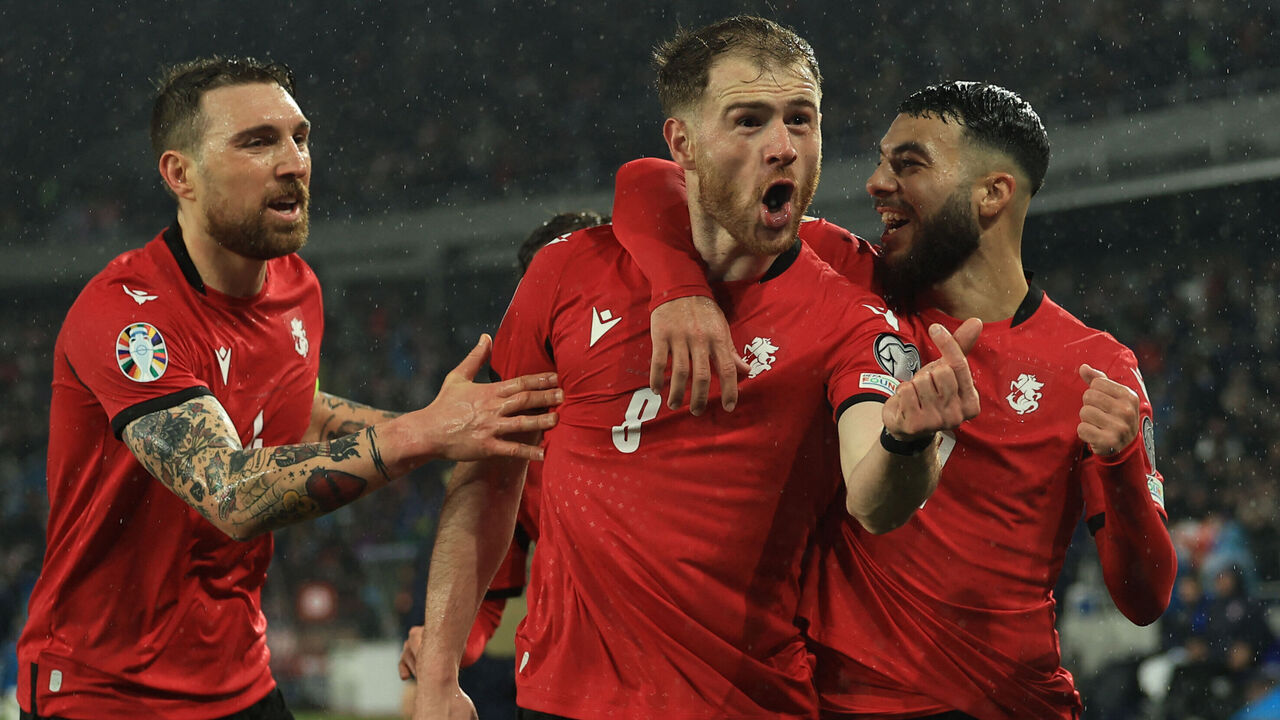
Georgia 2-0 Luxembourg
Two clever finishes from Budu Zivzivadze in Tbilisi assured Georgia of a place in Path C’s final – and all without the help of suspended talisman Khvicha Kvaratskhelia. But it wasn’t that simple for the host. Luxembourg thought it equalized during the second half, only for the goal to be eventually snatched away due to Maxime Chanot’s apparent foul 45 seconds earlier. Luxembourg’s Chanot was controversially sent off for denying a clear goal-scoring opportunity, and Zivzivadze effectively ended the match six minutes later with his second strike. Kvaratskhelia is available for the final.
Greece 5-0 Kazakhstan
Anastasios Bakasetas lashed home a penalty, Dimitrios Pelkas headed into the net’s roof, Fotis Ioannidis tapped in from close range, and Dimitrios Kourbelis added another header. And that was all before halftime. Kazakhstan’s impressive 2022-23 Nations League campaign and notable Euro 2024 qualifying wins over Denmark, Northern Ireland (twice), and Finland suddenly seemed ages ago, as Greece recorded its biggest halftime lead since October 1978 (5-0 against Finland). Aleksandr Marochkin’s embarrassing own goal in the 85th minute made Kazakhstan’s day even worse.
Playoff final: Georgia vs. Greece, Tuesday 1:00 p.m. ET
Copyright © 2024 Score Media Ventures Inc. All rights reserved. Certain content reproduced under license.
Premier League
Look: Nike unveils beautiful kit selection for Euro 2024, Copa America

Find the biggest stories from across the soccer world by visiting our Top Soccer News section and subscribing to push notifications.
Nike released a stunning batch of threads ahead of Euro 2024 and Copa America on Monday.
Days after Adidas launched its lineup for the summer’s top two tournaments, Nike followed suit with an array of colorful designs.
The U.S. manufacturer also announced redesigns for Canada and Poland, even though they’ve yet to qualify for their respective tournaments. The Canucks face Trinidad and Tobago in a one-off Copa America qualifier on Saturday, while Poland must navigate a four-team playoff to reach Euro 2024.
(All images courtesy of Nike)
Euro 2024
Croatia
Home

The square-shaped design that gives Croatia its unique look gets a slight upgrade. The home shirt features larger squares than ever before.
Away

Croatia’s away shirt plays on the national flag, with the traditional checkered pattern now on a slant.
England
Home

Influenced by England’s 1966 training gear, the home shirt has a classic feel with a rich blue collar and gorgeous trim along the cuffs.
Away

England embraces a deep purple hue for its away selection. The crest stands out with a contrasting off-white tint that makes the three lions pop.
France
Home

France’s home shirt may have the biggest crest of all of Nike’s offerings. The oversized rooster defines this shirt as much as the royal blue that’s made France’s kits a crowd-pleaser.
Away

The pinstripes mirror the colors of France’s national flag and span the width of the shirt in a simple, yet elegant design.
Netherlands
Home

Nike could’ve offered anything orange here, and it would’ve been perfect. But the Netherlands has something bolder and better to wear. The zig-zag pattern adds edge.
Away

The orange collar and cuffs pop alongside the three shades of blue Nike has chosen to create the abstract design on this work of art.
Poland
Home

Poland dedicates premium real estate on the country’s home shirt to its imposing crest.
Away

Poland’s away shirt is a daring choice. The graphic treatment adds texture, giving it a rugged feel while separating from the red tones of years past.
Portugal
Home

With possibly the best home shirt in Nike’s collection, Portugal leans heavily into its traditional red-and-green motif with a polo collar and thick cuffs. The logo sits prominently as well. A smash hit.
Away

Here’s another winner. Portugal’s away strip has a stunning textile imprint that gives off a cool summer vibe.
Turkey
Home

This is a menacing look. Turkey will look like a whirring red army with these imposing shirts.
Away

The classic red band returns to Turkey’s away uniform. Like the others, it features an oversized crest in the middle of the shirt.
Copa America
Brazil
Home

Nike goes big with Brazil’s crest and adds an intricate design to the same yellow hue the Selecao have used for decades.
Away

Brazil’s secondary strip feels like the beach. A horizontal wavy pattern covering the entire shirt mimics the country’s picturesque coastline.
Canada
Home

The only blemish in Nike’s lineup. Why is there a circle around the swoosh? And why are the shoulders so much darker than the body? None of it makes sense.
Away

The 13 pinstripes are supposed to represent the 10 provinces and three territories that make up Canada. Unfortunately, the rest of the shirt looks incomplete.
United States
Home

The United States men’s national team gets a classic home shirt with patriotic detailing along the color and sleeves.
Away

The gradient works perfectly with the red shorts the U.S. will wear at the Copa America.
Copyright © 2024 Score Media Ventures Inc. All rights reserved. Certain content reproduced under license.

Breaking down thrilling EPL title race with 10 games left

Euro 2024 playoffs: Miraculous Ukraine comeback, big result for Wales

Managerial merry-go-round: Predicting hires for marquee jobs

The Champions League's best XI so far

Ready Newest Trainer in Bundesliga History, retire SOLSKYER.

35 stars who will define the summer transfer window
Trending
-

 Champions League7 years ago
Champions League7 years agoThe Champions League's best XI so far
-

 Sports6 years ago
Sports6 years agoReady Newest Trainer in Bundesliga History, retire SOLSKYER.
-

 Serie A7 years ago
Serie A7 years ago35 stars who will define the summer transfer window
-

 Serie A7 years ago
Serie A7 years agoAjax show Juventus that winning requires more than individual quality
-

 Uncategorized5 years ago
Uncategorized5 years agoIFFHS publishes the list of top scorers in football history – Romario first, Ronaldo third
-

 Premier League7 years ago
Premier League7 years agoTransfer grades: Assessing Hazard’s move to Real Madrid
-

 Sports6 years ago
Sports6 years agoWenger: Hazard can’t replace Ronaldo.
-

 La Liga2 years ago
La Liga2 years agoLook: Adidas drops huge collection of new kits for Euro 2024, Copa America

